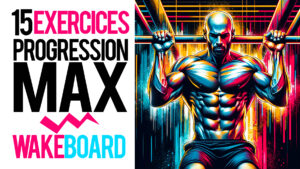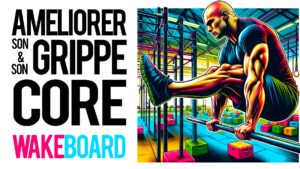Become a wakeboarding pro in 15 minutes
The position on the wake
Here is the basic position, shoulders above the board, arms semi-flexed, chest straight, squeeze your glutes which will make you retrovert your pelvis and depending on the effort, contract your abdominals. I usually use a little device during the camps to make people understand the position. Imagine a nut and you squeeze it between your buttocks. The goal is that it does not fall. With this method you will keep a good basic position. At the end of the day you can clean the nut, it can still be used.
The cuts
The heelside cut :
Heel side indicates that you will lean back. And again I insist on the position we saw in the previous point because if you keep your buttocks back you won't be able to take an angle and an important cut and you will miss your turns, or even be pulled forward by the pull of the rope. The goal is to let yourself go against the pull of the rope while keeping your back straight and aligned.
Toeside or toeside cut:
This time we are going to lean forward and wrap ourselves very slightly around the rudder bar. The first challenge of this cut is to counteract the pull of the rope. Indeed, the rope will tend to pull us backwards. It is therefore important to understand the position in order to avoid being unwound. Position your back forearm on your navel and ask for help from your front hand by closing the angle of your front shoulder. This position will help you keep your shoulders in line with the wakeboard and thus you will be pulled in profile. All that remains is to lean on your toes while keeping a flex position on your wakeboard. The chest must be well sheathed. For those who think that a toe side cut is done with only one hand, know that the basic position of the toe side is so made and that it will be essential for you to know this one in order to carry out tricks such as the scarecrow, crowmob, and other figures of this kind. Also it helps you to keep energy in your front arm because the traction is done on the back hand.
Practice wetting the modules by making turns to make water sprays that will come in handy later on.
My first module!
If you have arrived here, it's time to make your first slides on modules. Already think of wetting the modules otherwise it hurts. It is therefore important to have understood the position on your wake because it will be decisive for the rest. Balance is the rule. The modules are slippery and your weight on the wakeboard must be distributed in order not to go forward or backward once on the module. It will be important for the first times to take a wide and not very high module to absorb your entry while keeping your balance on it.
To do this, you will take a progressive cut in the direction of the obstacle such as funbox, box or flat bar and will put your wakeboard back on the flat 2 meters before it. It is now a question of keeping your balance because the change of surface will be felt. Stay flexible on your legs while keeping the initial position. Cushion the entry and slide your wakeboard flat all the way. Release your back hand and keep your arms semi-flexed to avoid getting caught in the rope if your arm is extended.
Basic tricks
Je vais vous proposer un ordre de progression partant du tout débutant qui ne sait pas faire du wakeboard à un niveau plus intermédiaire. A partir du moment où vous arrivez à faire un tour sur téléski nautique 2.0, passez au 5.0. Comme dit plus tôt, faites des ollies, des 180 glissés dans les 2 sens, des 360 glissés dans les 2 sens aussi pour ensuite prendre vos premiers kickers et modules. Je vais surtout vous recommander de réaliser tout ce que vous faites de votre bon pied en switch. Beaucoup de rider arrivent aux camps et me disent qu’ils ne rident quasiment jamais en switch. Du coup impossible de prendre tous les modules. Surtout quand vous arrivez dans des parks techniques et qui vous demandent des ressources physiques. La plus part du temps les stagiaires finissent par accepter et apprennent à rider en switch durant le camp. N’attendez pas d’avoir de lacunes pour progresser en switch.
Traumatology and Safety (learning to fall)
- Instead of telling you how important it is to wear good and protective equipment, I would like to explain 2-3 important points about falls and wakeboarding trauma. What areas of the body are affected ?
- The back
- The cervicals
- The knees
- The shoulders
- Du coup, il faut toujours bien se préparer avant sa session, C’est à dire :
- Stretch and warm up a little before your first rope.
- Increase the intensity of the session (first rope we turn, second we do 2-3 funboxes, 3rd we start to take the kickers, etc)
- Don't forget to stay hydrated during your sessions as well as a small snack mid-ride to boost your energy! You consume about 350kcal per hour of riding.
- Pensez bien à la gestion du temps : si vous ridez toute la journée, n’hésitez pas à prendre des pauses afin de tenir plus longtemps et mieux durant vos sessions. Le but est d’être intense sur de courtes périodes plutôt que de rider toute la journée et de ne plus être capable de tenir physiquement.
- For my part, between my weekly sessions I do yoga to strengthen my muscles and especially to release toxins.



